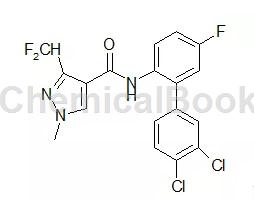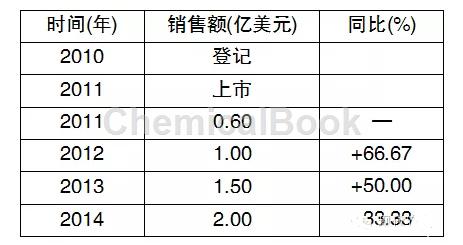Bixafen is a pyrazole amide fungicide developed by Crop Science. It is an important member of the fastest growing succinate dehydrogenase inhibitor (SDHI) fungicides. It was made public in 2006, first published in 2010, listed in 2011, and produced by the company. Other companies currently involved in the development include FMC and Sumitomo Chemical, and its annual peak sales are expected to exceed 300 million euros.
Bifenzofen is another blockbuster fungicide jointly created by multiple companies.
Product performance is outstanding
The development code of bifenzofen is: BYF 00587; original drug content ≥950 g/kg; CAS registration number: [581809-46-3]; molecular formula: C18H12Cl2F3N3O; relative molecular mass: 414.21; IUPAC name: N-(3′,4′-dichloro-5-fluorobiphenyl-2-yl)-3-(difluoromethyl)-1-methylpyrazole-4-amide. Its chemical structural formula is shown in Figure 1.

Figure 1 Chemical structural formula of bifenzofen
Bifenizumab interferes with the succinate dehydrogenase on complex II in the mitochondrial respiratory electron transport chain of pathogenic bacteria, inhibits mitochondrial function, prevents it from producing energy, inhibits the growth of pathogenic bacteria, and ultimately leads to its death.
Bifefenpyrid is a systemic fungicide with a broad bactericidal spectrum and is specially used for foliar spraying. It can effectively prevent and control important diseases caused by ascomycetes, basidiomycetes and deuteromycetes on cereal crops. Tests have proven that bifenzofen has excellent control effects on many diseases on wheat crops, such as wheat leaf blight (Septoria tritici), leaf rust (Puccinia triticina), stripe rust (Puccinia striiformis), eye spot ( Oculimacula spp.) and yellow spot (Pyrenophora tritici-repentis), etc., as well as barley net spot (Pyrenophora teres), Ramularia collo-cygni, moire (Rhynchosporium secalis) and leaf rust (Puccinia hordei), etc., and can prevent and control leaf spot (Septoria tritici) caused by Septoria tritici pathogens that are resistant to methoxyacrylate fungicides.
It is reported that bifenzofen has a good therapeutic and protective effect on barley net spot and apple powdery mildew; its compound product with prothioconazole is effective against Septoria spp. Diseases have very good activity.
European Union registration takes the first step
In 2008, a registration application for bifenzofen was submitted to the UK. In September 2010, Aviator Xpro, a compound product of bifenzofen and prothioconazole, was approved for registration in the UK for use on wheat and barley. In the same year, the compound product was registered in Germany. In 2011, the Xpro series of products based on bifenac were first launched in the UK, Germany, France, Ireland and Chile, and then in many European markets.
On October 1, 2013, bifenzofen was included in the list of registered active ingredients in the EU Pesticide Registration Regulation (1107/2009), which is valid until September 30, 2023. The UK is the drafting country of the document. Currently, bifenzofen is available in 18 EU member states (Austria, Belgium, Bulgaria, Czech Republic, Germany, Estonia, France, Hungary, Ireland, Italy, Lithuania, Luxembourg, Latvia, the Netherlands, Poland, Romania, Slovakia, and the United Kingdom). ) has been registered, and 4 member states (Spain, Finland, Sweden and Slovenia) are currently registering.
Registration requirements, EU member states must pay special attention to: residues of diphenoxyfen and its metabolites in rotation crops; when used in areas with fragile soil and/or climatic conditions, attention should be paid to the impact on groundwater Conservation; be aware of risks to aquatic life; be aware of risks to organisms that inhabit soil and sediments.
In the European market, 125 g/L diphenoxylin EC foliar spray is used for wheat, rye, triticale, barley and oats to prevent and control stem and leaf diseases.
Companies such as FMC and Sumitomo Chemical are also involved in the development of bifenzofen in other markets.
FMC has obtained an exclusive license to develop and distribute bifenzofen in the United States and Canada. FMC will develop a range of products based on bifenzofen, thereby further growing the market for this active ingredient. The company is in the process of registering multiple compound products of bifenzofen.
Recently, FMC, the U.S. Environmental Protection Agency (EPA) and the Canadian Pest Management Regulatory Authority (PMRA) have jointly promoted the registration of bifenzofen. The registered crops include corn, soybeans, cereals, canola, peanuts and potatoes. Submitted registration information shows that bifenzofen can effectively control corn leaf blight and gray leaf spot, soybean gray spot, brown spot and white rot; leaf spot caused by Septoria on cereals , stripe rust and stem rust; potato early blight and white rot; rapeseed white rot; peanut stem rot, leaf spot, leaf rust and stem rot caused by Rhizoctonia.
FMC is the world’s leading provider of plant protection solutions. Through strategic alliances, cooperation and acquisitions, the company’s R&D pipeline already has 16 new synthetic and biological active ingredients, including bifenzofen. The product will be on the market within the next 7 years.
In addition, the Australian Pesticides and Veterinary Medicines Authority (APVMA) has also approved the registration of Aviator Xpro (75 g/L diphenoxylin + 150 g/L prothioconazole), a foliar fungicide from Atomo Chemical, for control. Barley, oats, triticale, �Foliar diseases on crops such as wheat and rapeseed.
As of October 2016, bifenzofen has not yet been registered in my country.
The main compound products of bifenfenpyr are: Aviator Xpro, Aviator 235 Xpro, Siltra Xpro (+ prothioconazole), SkywayXpro (+ prothioconazole + tebuconazole), Input Mycloconazole + spirolostrobin), VarianoXpro (+ prothioconazole + fluoxastrobin), and Zantara (+ tebuconazole), etc. Compatible products include not only prothioconazole, but also tebuconazole, fluoxastrobin, and spironil; there are both two-component and three-component compounds.
Market development is like a duck in water
Bifenizumab has been like a duck in water since it was launched in 2011, and its market has developed rapidly. Especially with the successful launch of the Xpro series of compound products of bifenpyrid and prothioconazole, the market has grown significantly. In 2011, the Xpro series was widely introduced to the market, and its sales in the first half of the year exceeded 100 million euros.
2011 was the first year that bifenzofen was launched. In this year, its global sales were US$60 million, ranking third among this type of products, accounting for 10.3% of the sales of SDHI fungicides that year. In 2012, its global sales were US$100 million; in 2013, it was US$150 million, a year-on-year increase of 50.00%; in 2014, its sales were US$200 million, still ranking third among SDHI fungicides, accounting for 10% of the total. 14.6% of the market.
From 2011 to 2014, the compound annual growth rate of bifenzofen was 49.38%. The expected annual peak sales of bifenzofen are 300 million euros, and it will become another blockbuster product of the company.
In 2014, the top five products among SDHI fungicides were: boscalid, triflufenac, bifenac, triflufen and triflufen. Total sales were US$1.09 billion, accounting for 79.4% of the market for this type of product. In recent years, SDHI fungicides have grown rapidly, and their rankings have been constantly refreshed.
Table 1 Global sales of bifenzofen

It will take time for the patent to expire
Bifenfenpyr is still within the patent protection period. Its world patent (WO2006024388) and European patent (EP1784383) were applied for on August 13, 2005 and terminated on August 12, 2025; U.S. patent (US7750186) The application was filed on August 13, 2005 and will end on August 13, 2025.
The European Patent Office website shows that the compound patents of bifenzofen also include: German patent (DE102004041531) and Japanese patent (JP2008510745). No Chinese patents were found.
The market outlook is optimistic and promising
Bifenzofen is a new product with high hopes and has been registered and marketed in many countries, including 18 EU countries, Chile and Australia. Among them, the compound product with prothioconazole is the company’s strong brand. According to the report, the compound product of bifenfenpyrid and prothioconazole can provide “unparalleled” long residual effect and broad-spectrum bactericidal effect; it also has a positive impact on plant physiology, can increase crop stress tolerance, and improve Crop yield.
The sales of bifenzofen, which was launched in 2011, reached US$200 million in 2014, with a compound annual growth rate of nearly 50% in the past five years.
Today, in addition to developing bifenzofen, FMC and Sumitomo Chemical are involved in it and promote it as the company’s key new product.
The current market growth of bifenzofen is rapid, and the future market is still optimistic.

 微信扫一扫打赏
微信扫一扫打赏

